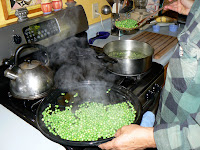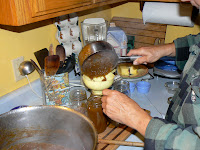We have had a good crop of basil this year. Basil does not grow outdoors here. It is clearly not warm enough here along the coast for basil to grow well outdoors, so I grow it in pots in the greenhouse, and keep it on the heat mats there. I grew three different basils this year, spicy globe basil, Genovese basil, and Sweet Basil. I couldn't tell any difference between the last two in looking at them, but they had a slightly differing aroma. The spicy globe basil was a small leaved variety, the other two were large leaved.
I picked the basil with scissors this morning, cutting the stems way down, but leaving a section to regrow on each plant. I am hoping for a second crop later in the summer. I harvested at least 10 cups of basil leaves from the plants, reserved 6 cups or so for my pesto making, and walked around to my neighbors and gave them each some of the basil leaves.
Making pesto
I try to make pesto each year, freezing some to use later in the year. I use a traditional method to make pesto, utilizing a mortar and pestle and hand crushing the basil leaves, garlic, salt, peppercorns, roasted pine nuts, parmesan cheese, and olive oil. This year I followed the recipe in the cookbook "Chez Panisse Pasta Pizza & Calzone" by Alice Waters, Patricia Curtan & Martine Labro.
I usually freeze the pesto into cubes, then package them up to keep in the freezer until needed. Here is a photo of the ice cube tray with the frozen pesto cubes. They don't really freeze all that solid, probably because of all the olive oil and oil from the pine nuts in the mix.
I replanted pole beans today in two varieties, Blue Lake, and Romano, to replace the failed earlier planting. One final chore remained-spraying the espaliered fruit trees with micronized sulfur. This is water soluble sulfur for use in a sprayer. Sulfur is an element which is helpful for the prevention of fungal diseases and will hopefully prevent scab on the apples and pears. My wife noted that I was a bit grumpy after the spraying. I think I react to the inevitable spray drift which gets on me. A shower restored my spirits (or maybe it was the stuffed salmon and lovely bio-dynamic Maysara winery pinot noir for dinner that did the trick.)




















































